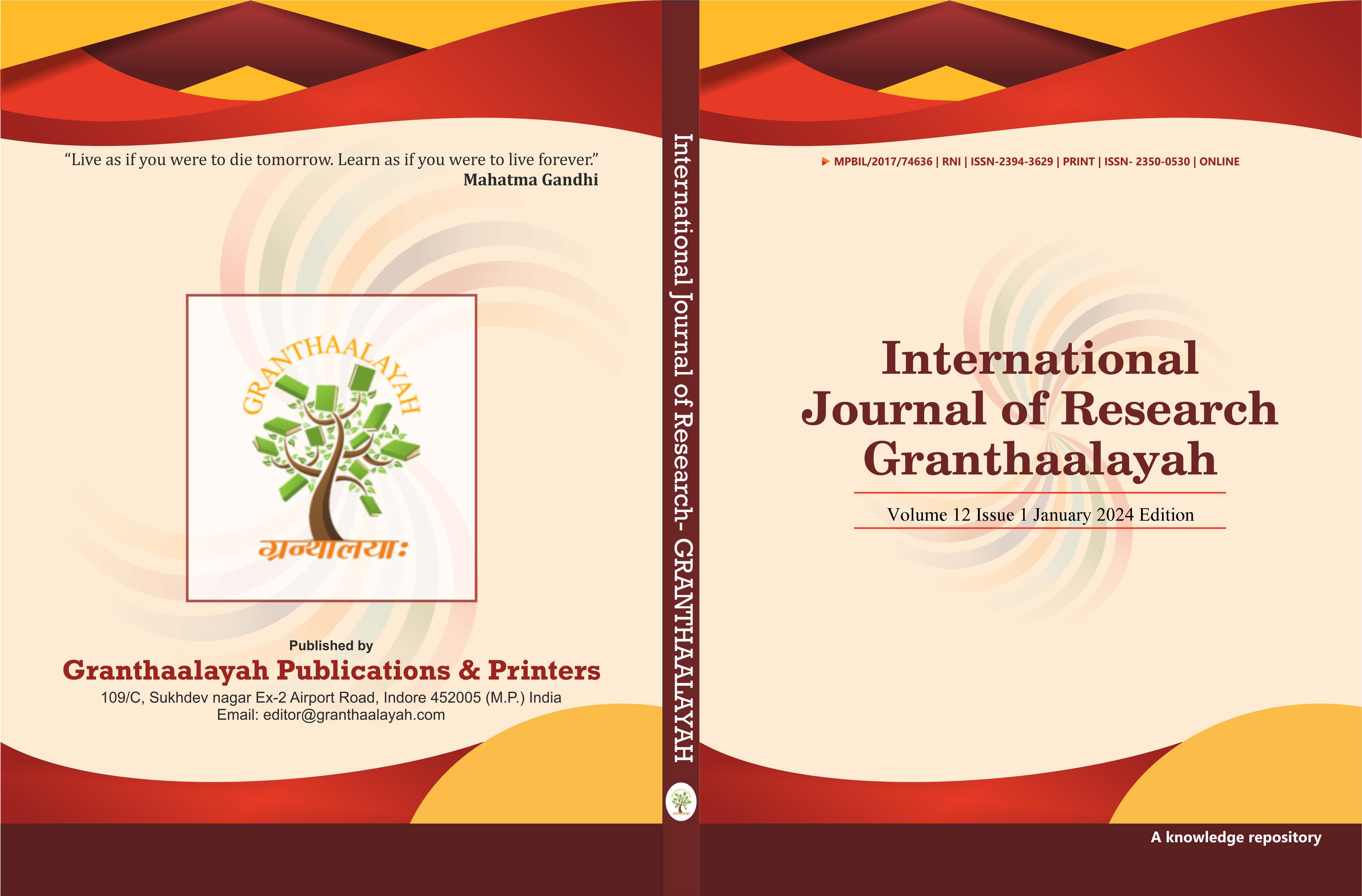CONVERSION TO OPEN CHOLECYSTECTOMY - A SAFE ALTERNATIVE, NOT A FAILURE!
DOI:
https://doi.org/10.29121/granthaalayah.v12.i1.2024.5483Keywords:
Cholecystectomy, Cholecystectomy Cholelithiasis, Gall Bladder, Laparoscopic CholecystectomyAbstract [English]
Background: Understanding factors that predict conversion in laparoscopic cholecystectomy (LC) to an open procedure is important as it allows better patient selection, preparation, operating list planning, referral, counseling and lowers the threshold for a safe conversion, thereby minimizing undue prolongation of attempts at laparoscopic completion and inadvertent complications.
Methods: Records of 1010 consecutive patients who were taken up for LC, at a tertiary care teaching institute in northern India, were reviewed retrospectively. Preoperative and intraoperative characteristics of patients who underwent a successful LC were compared with those who required conversion to open surgery.
Results: The conversion rate was 7.5% (76 patients). The most common reason for conversion was the inability to define the ‘Critical view of safety’ in 48, (63%) of patients. Other reasons included dense peri-cholecystic 9 (12%) and intra-abdominal 8 (11%) adhesions, suspicion of bile duct injury 4 (5%) or malignancy 3 (4%). Prior upper abdominal surgery, intraoperative finding of a contracted and thick-walled gallbladder (GB), empyema GB, Mirizzi’s syndrome, cholecysto-enteric fistula, and a prior endoscopic common bile duct stone clearance were significant predictors of conversion. Xanthogranulomatous cholecystitis was found more commonly (43% vs 5%) in the conversion group.
Conclusion: Conversion to an open procedure during LC should always be treated as an integral component of sound judgement to achieve the safest outcome in a particular patient. Due consideration of pre-operative and intra-operative factors predictive of a higher chance of conversion assists pre-operative patient preparation and counseling as well as surgical planning, conduct and mentoring of residents-in-training.
Downloads
References
Al Masri, S., Shaib, Y., Edelbi, M., Tamim, H., Jamali, F., Batley, N., Faraj, W., & Hallal, A. (2018). Predicting Conversion from Laparoscopic to Open Cholecystectomy: A Single Institution Retrospective Study. World J Surg., 42(8), 2373-82. https://doi.org/10.1007/s00268-018-4513-1 DOI: https://doi.org/10.1007/s00268-018-4513-1
Ambe, P.C., Jansen, S., Macher-Heidrich, S., & Zirngibl, H. (2016). Surgical Management of Empyematous Cholecystitis: A Register Study of Over 12,000 Cases from a Regional Quality Control Database in Germany. Surg Endosc, 30(12), 5319-24. https://doi.org/10.1007/s00464-016-4882-1 DOI: https://doi.org/10.1007/s00464-016-4882-1
Ballal, M., David, G., Willmott, S., Corless, D.J., Deakin, M., & Slavin, J.P. (2009). Conversion After Laparoscopic Cholecystectomy in England. Surg Endosc, 23(10), 2338-44. https://doi.org/10.1007/s00464-009-0338-1 DOI: https://doi.org/10.1007/s00464-009-0338-1
Banks, P.A., Bollen, T.L., Dervenis, C., Gooszen, H.G., Johnson, C.D., Sarr, M.G., Tsiotos, G. G., & Vege, S. S. (2013). Classification of Acute Pancreatitis-2012: Revision of the Atlanta Classification and Definitions by International Consensus. Gut, 62(1), 102-11. https://doi.org/10.1136/gutjnl-2012-302779 DOI: https://doi.org/10.1136/gutjnl-2012-302779
Barrett, M., Asbun, H.J., Chien, H.-L., Brunt, L.M., & Telem, D.A. (2018). Bile Duct Injury and Morbidity Following Cholecystectomy: A Need for Improvement. Surg Endosc, 32(4), 1683-8. https://doi.org/10.1007/s00464-017-5847-8 DOI: https://doi.org/10.1007/s00464-017-5847-8
Beltran, M.A., Csendes, A., & Cruces, K.S. (2008). The Relationship of Mirizzi Syndrome and Cholecystoenteric Fistula: Validation of a Modified Classification. World J Surg, 32(10), 2237-43. https://doi.org/10.1007/s00268-008-9660-3 DOI: https://doi.org/10.1007/s00268-008-9660-3
Chaudhary, A., Manisegran, M., Chandra, A., Agarwal, A K., & Sachdev, A. K. (2001). How Do Bile Duct Injuries Sustained During Laparoscopic Cholecystectomy Differ from Those During Open Cholecystectomy? J Laparoendosc Adv Surg Tech, 11(4), 187-91. https://doi.org/10.1089/109264201750539682 DOI: https://doi.org/10.1089/109264201750539682
Chen, H., Siwo, E.A., Khu, M., & Tian, Y. (2018, Jan 26). Current Trends in the Management of Mirizzi Syndrome. Medicine (Baltimore) [Internet]. [Cited 2020 Jun 18], 97(4). DOI: https://doi.org/10.1097/MD.0000000000009691
Chowbey, P., Sharma, A., Goswami, A., Afaque, Y., Najma, K., Baijal M, Soni, V., & Khullar, R. (2015). Residual Gallbladder Stones After Cholecystectomy: A Literature Review. J Minimal Access Surg, 11(4), 223-30. https://doi.org/10.4103/0972-9941.158156 DOI: https://doi.org/10.4103/0972-9941.158156
Chowbey, P.K., Bandyopadhyay, S.K., Sharma, A., Khullar, R., Soni, V., & Baijal, M. (2006). Laparoscopic Management of Cholecystoenteric Fistulas. J Laparoendosc Adv Surg Tech A, 16(5), 467-72. https://doi.org/10.1089/lap.2006.16.467 DOI: https://doi.org/10.1089/lap.2006.16.467
Dutta, U., Bush, N., Kalsi, D., Popli, P., & Kapoor, V.K. (2019). Epidemiology of Gallbladder Cancer in India. Chin Clin Oncol, 8(4), 4. https://doi.org/10.21037/cco.2019.08.03 DOI: https://doi.org/10.21037/cco.2019.08.03
Ercan, M., Bostanci, E.B., Teke, Z., Karaman, K., Dalgic, T., Ulas, M., Ozer, I., Ozogul, Y. B., Atalay, F., & Akoglu, M. (2010). Predictive Factors for Conversion to Open Surgery in Patients Undergoing Elective Laparoscopic Cholecystectomy. J Laparoendosc Adv Surg Tech A, 20(5), 427-34. https://doi.org/10.1089/lap.2009.0457 DOI: https://doi.org/10.1089/lap.2009.0457
Fong, Z.V., Pitt, H.A., Strasberg, S.M., Loehrer, A.P., Sicklick, J.K., Talamini, M.A, Lillemoe, K., Chang, D., California Cholecystectomy Group (2018). Diminished Survival in Patients with Bile Leak and Ductal Injury: Management Strategy and Outcomes. J Am Coll Surg, 226(4), 568-576. https://doi.org/10.1016/j.jamcollsurg.2017.12.023 DOI: https://doi.org/10.1016/j.jamcollsurg.2017.12.023
Friis, C., Rothman, J.P., Burcharth, J., & Rosenberg, J. (2018). Optimal Timing for Laparoscopic Cholecystectomy After Endoscopic Retrograde Cholangiopancreatography: A Systematic Review. Scand J Surg SJS Off Organ Finn Surg Soc Scand Surg Soc, 107(2), 99-106. https://doi.org/10.1177/1457496917748224 DOI: https://doi.org/10.1177/1457496917748224
Gupta, V., & Jain, G. (2019). Safe Laparoscopic Cholecystectomy: Adoption of Universal Culture of Safety in Cholecystectomy. World J Gastrointest Surg, 11(2), 62-84. https://doi.org/10.4240/wjgs.v11.i2.62 DOI: https://doi.org/10.4240/wjgs.v11.i2.62
Halbert, C., Pagkratis, S., Yang, J., Meng, Z., Altieri, M.S, Parikh, P., Aurora Pryor, Talamini, M., & Telem, D. A. (2016). Beyond the Learning Curve: Incidence of Bile Duct Injuries Following Laparoscopic Cholecystectomy Normalize to Open in the Modern Era. Surg Endosc, 30(6), 2239-43. https://doi.org/10.1007/s00464-015-4485-2 DOI: https://doi.org/10.1007/s00464-015-4485-2
Hale, M.D., Roberts, K.J., Hodson, J., Scott, N., Sheridan, M., & Toogood, G.J. (2014). Xanthogranulomatous Cholecystitis: A European and Global Perspective. HPB. 16(5), 448-58. https://doi.org/10.1111/hpb.12152 DOI: https://doi.org/10.1111/hpb.12152
Kapoor, V.K. (2020). Epidemiology of Bile Duct Injury. In: Kapoor VK, Editor. Post-Cholecystectomy Bile Duct Injury [Internet]. Singapore: Springer, [Cited 2020 Oct 6], 11-9. https://doi.org/10.1007/978-981-15-1236-0_2 DOI: https://doi.org/10.1007/978-981-15-1236-0_2
Kapoor, V.K., Kumar, A., Sikora, S.S., & Kaushik, S.P. (1995). Conversions in Laparoscopic Cholecystectomy--Need for a New Nomenclature. Trop Gastroenterol Off J Dig Dis Found, 16(3), 38-9.
Keus, F., Gooszen, H.G., & U Laarhoven, C.J. (2010). Open, Small-Incision, or Laparoscopic Cholecystectomy for Patients with Symptomatic Cholecystolithiasis. An Overview of Cochrane Hepato-Biliary Group Reviews. Cochrane Database Syst Rev [Internet]. 2010 Jan 20 [Cited 2020 Jun 19], (1). https://doi.org/10.1002/14651858.CD006229 DOI: https://doi.org/10.1002/14651858.CD006229
Kohn, J.F., Trenk, A., Kuchta, K., Lapin, B., Denham, W., Linn, J.G., Haggerty, S., Joehl, R., & Ujiki, M. B. (2018). Characterization of Common Bile Duct Injury After Laparoscopic Cholecystectomy in a High-Volume Hospital System. Surg Endosc, 32(3), 1184-91. https://doi.org/10.1007/s00464-017-5790-8 DOI: https://doi.org/10.1007/s00464-017-5790-8
Lo, H.-C., Wang, Y.-C., Su, L.-T., & Hsieh, C.-H. (2012). Can Early Laparoscopic Cholecystectomy be the Optimal Management of Cholecystitis with Gallbladder Perforation? A Single Institute Experience of 74 Cases. Surg Endosc, 26(11), 3301-6. https://doi.org/10.1007/s00464-012-2344-y DOI: https://doi.org/10.1007/s00464-012-2344-y
Malik, A., Laghari, A.A., Talpur, K.A.H., Memon, A., Mallah, Q., & Memon J.M. (2007). Laparoscopic Cholecystectomy in Empyema of Gall Bladder: An Experience at Liaquat University Hospital, Jamshoro, Pakistan. J Minimal Access Surg, 3(2), 52-6. https://doi.org/10.4103/0972-9941.33273 DOI: https://doi.org/10.4103/0972-9941.33273
Niemeier, O.W. (1934). Acute Free Perforation of the Gall-Bladder. Ann Surg, 99(6), 922-4. https://doi.org/10.1097/00000658-193499060-00005 DOI: https://doi.org/10.1097/00000658-193499060-00005
Philip Rothman, J., Burcharth, J., Pommergaard, H.-C., Viereck, S., & Rosenberg, J. (2016). Preoperative Risk Factors for Conversion of Laparoscopic Cholecystectomy to Open Surgery - A Systematic Review and Meta-Analysis of Observational Studies. Dig Surg, 33(5), 414-23. https://doi.org/10.1159/000445505 DOI: https://doi.org/10.1159/000445505
Puggioni, A., & Wong, L.L. (2003). A Metaanalysis of Laparoscopic Cholecystectomy in Patients with Cirrhosis. J Am Coll Surg, 197(6), 921-6. https://doi.org/10.1016/j.jamcollsurg.2003.08.011 DOI: https://doi.org/10.1016/j.jamcollsurg.2003.08.011
Qasaimeh, G.R., Matalqah, I., Bakkar, S., Al Omari, A., & Qasaimeh, M. (2015). Xanthogranulomatous Cholecystitis in the Laparoscopic Era Is Still a Challenging Disease. J Gastrointest Surg, 19(6), 1036-42. https://doi.org/10.1007/s11605-015-2818-z DOI: https://doi.org/10.1007/s11605-015-2818-z
Seetahal, S., Obirieze, A., Cornwell, E.E., Fullum, T., & Tran, D. (2015). Open Abdominal Surgery: A Risk Factor for Future Laparoscopic Surgery? Am J Surg, 209(4), 623-6. https://doi.org/10.1016/j.amjsurg.2014.12.017 DOI: https://doi.org/10.1016/j.amjsurg.2014.12.017
Strasberg, S.M. (2013). A Teaching Program for the "Culture of Safety in Cholecystectomy" and Avoidance of Bile Duct Injury. J Am Coll Surg, 217(4), 751. https://doi.org/10.1016/j.jamcollsurg.2013.05.001 DOI: https://doi.org/10.1016/j.jamcollsurg.2013.05.001
Strasberg, S.M., & Gouma, D.J. (2012). 'Extreme' Vasculobiliary Injuries: Association with Fundus-Down Cholecystectomy in Severely Inflamed Gallbladders. HPB, 14(1), 1-8. https://doi.org/10.1111/j.1477-2574.2011.00393.x DOI: https://doi.org/10.1111/j.1477-2574.2011.00393.x
Strasberg, S.M., Hertl, M., & Soper, N.J. (1995). An Analysis of the Problem of Biliary Injury During Laparoscopic Cholecystectomy. J Am Coll Surg, 180(1), 101-25.
Sutcliffe, R.P., Hollyman, M., Hodson, J., Bonney, G., Vohra, R.S., Griffiths, E.A., et al. (2016). Preoperative Risk Factors for Conversion from Laparoscopic to Open Cholecystectomy: A Validated Risk Score Derived from a Prospective U.K. Database of 8820 Patients. HPB, 18(11), 922-8. https://doi.org/10.1016/j.hpb.2016.07.015 DOI: https://doi.org/10.1016/j.hpb.2016.02.012
Zdichavsky, M., Bashin, Y.A., Blumenstock, G., Zieker, D., Meile, T., & Königsrainer, A. (2012). Impact of Risk Factors for Prolonged Operative Time in Laparoscopic Cholecystectomy. Eur J Gastroenterol Hepatol, 24(9), 1033-8. https://doi.org/10.1097/MEG.0b013e328354ad6e DOI: https://doi.org/10.1097/MEG.0b013e328354ad6e
Published
How to Cite
Issue
Section
License
Copyright (c) 2024 Gaurav Singh, Anu Behari, Anand Prakash, Rajneesh Kumar Singh, Ashok Kumar Gupta, Vinay K Kapoor, Rajan Saxena

This work is licensed under a Creative Commons Attribution 4.0 International License.
With the licence CC-BY, authors retain the copyright, allowing anyone to download, reuse, re-print, modify, distribute, and/or copy their contribution. The work must be properly attributed to its author.
It is not necessary to ask for further permission from the author or journal board.
This journal provides immediate open access to its content on the principle that making research freely available to the public supports a greater global exchange of knowledge.

























